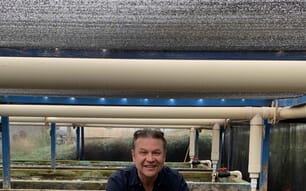As part of the USD 4 million ‘Partnership for Aquaculture Development in Timor-Leste’ project, the hatchery for Genetically Improved Farmed Tilapia (GIFT) was inaugurated by H. E. Estanislau da Silva, Minister of Agriculture and Fisheries, and Ambassador of New Zealand, Jonathan Schwass.
GIFT was first supplied to Timor-Leste in April 2015 when 10,200 brood stock were sent from WorldFish Headquarters, Penang Malaysia to the Gleno Fish Hatchery in Ermera.
In parallel the construction and refurbishment of the new hatchery at Gleno was undertaken, with work completed in December 2015 and operations starting from early January 2016.
WorldFish developed the GIFT strain, which thrives in a wide range of environments and can grow 50-80 per cent faster than other strains of non-improved fish. It is currently produced in 14 countries, requires no antibiotics and has a lower carbon footprint than either beef or pork. From a nutritional point of view it is an affordable source of heart friendly omega-3 fatty acids and micronutrients that are vital for childhood development and pregnant mothers.
In view of the need to make this a sustainable enterprise, emphasis is given to capacity building and together with the Asian Institute of Technology and WorldFish, a business plan has been developed.
Now the hatchery has the potential of producing up to 5 million fish fry per year. Fry can, in turn, be supplied to support Timor-Leste’s burgeoning aquaculture industry and proceeds can be ploughed back into the hatchery for running costs and development.
Its systematic brood stock management and fingerling production system underpins a key aim of the new hatchery, which is to maintain the genetic integrity of the brood stock thereby ensuring that the inherent productivity gains are preserved.
Ambassador of New Zealand, Jonathan Schwass: “Aquaculture is one of New Zealand’s most important areas of activity in Timor-Leste. It has the potential to dramatically increase the amount of protein available to families, and help farmers improve the viability of their businesses.”
H. E. Estanislau da Silva, Minister of Agriculture and Fisheries: “Aquaculture development is one of the top priorities for this government. And tilapia, in particular, holds great potential because of its versatility, nutritional qualities and potential to address the availability of fish, in particular for resource poor communities.”
Director General, WorldFish, Nigel Preston: “Timor-Leste has in place an ambitious business plan to build the aquaculture sector and this hatchery will play a pivotal role in the supply of good quality brood stock and seed that will ensure that some of those key goals can be met. With aquaculture providing such promise in improving food and nutrition security for the Timorese, WorldFish remains fully committed to supporting the growth of the sector.”
The New Zealand Aid Programme funded ‘Partnership for Aquaculture Development in Timor-Leste’ project has been and will continue working to develop the Timor-Leste fish farming industry, carry out training, improve planning, develop seed and feed supply systems and help to connect fish growers to markets. The project is led by the National Directorate of Fisheries and Aquaculture (NDFA) with assistance from New Zealand’s National Institute of Water and Atmospheric Research Ltd (NIWA), WorldFish, and Tisbe.




